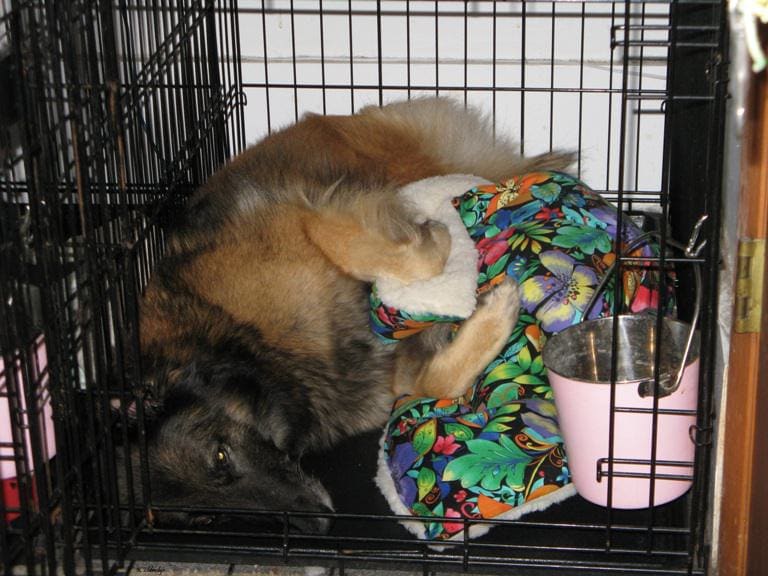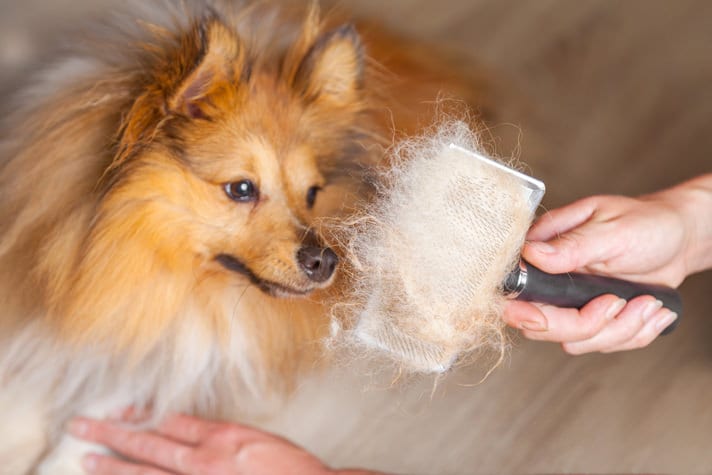Whether you just got a new puppy from a breeder or an older dog from a rescue, dog crate training is a topic that is bound to come up. Here is information on what crate training is, why it is good for your dog and how to get started.
What Is Crate Training?
Crate training, also known as dog kennel training, is teaching your dog to wait patiently when you put him or her in a crate. Many dogs and puppies are already used to being crated before they go to their new homes, but others may not have had that experience or may need a refresher in a new setting. As an owner, your goal is to make your dog’s crate a happy and safe place for him to hang out when he can’t be loose.
Why Should I Crate Train My Dog?
Being comfortable in a crate is a valuable skill for dogs of all ages. For starters, crate training is an excellent way to work on housebreaking your new dog, because dogs naturally avoid eliminating in their personal space. Crating is also a safe and easy way to keep your dog confined when you are out of the house until he can be trusted not to chew or destroy things in your absence. If you have multiple dogs, crating at mealtimes is an easy way to make sure that each dog gets to eat all of his food. When going somewhere with your dog, a crate in your car is the safest way for him to travel, because it both prevents him from interfering with your driving and also protects him in the event of a crash.
There will also probably be times in your dog’s life when he has to be crated, such as while staying at a boarding kennel or if he needs to stay at the veterinary clinic for a treatment or surgery. Some injuries also require your dog’s activity and exercise to be limited during the healing process. These events and other emergencies will already be stressful for your dog, but being comfortable in a crate will make the experience a much happier one for him. Your dog’s crate is like his own private bedroom.
What Dogs Can Be Crate Trained?
Almost any dog can be crate trained. Dogs are den animals who naturally like having a cozy, enclosed space to sleep and relax. My dogs love their crates and will go in on their own for naps or to hoard favorite toys when the doors are left open.
If your dog has separation anxiety, resource guarding or other severe behavioral problems, consult with a certified canine behaviorist before starting crate training. Done right, crate training can be very beneficial to some of these dogs, because it gives them a sense of security, but crating could also exacerbate some problem behaviors. Your dog may need a specialized approach to crate training or even to not be crated at all. If your dog panics when in a crate, let him out immediately to prevent him from hurting himself. Whether or not crating works for a dog with behavioral problems, he will also need other types of training and management to help him lead a happy and comfortable life.
Never use crating as a punishment for your dog. You want your dog to be happy and relaxed in his crate, not fearful and anxious. Crating is also not a substitute for exercising an active dog. Young dogs especially need lots of exercise and attention, and will be much more likely to sleep quietly in a crate once those needs have been met.

Crate training is not only for puppies; most dogs of all ages can learn to enjoy being in a crate for short periods. Courtesy of Katherine Eldredge
What Type And Size Of Dog Crate Should I Get?
You can get dog crates at most pet supply stores, or order one online. Some department stores also have dog crates, but they may have limited options. Three main types of dog crates exist: solid, wire and soft-sided.
Solid crates are made of durable material, such as plastic, wood or metal. Generally the doors are made of wire or metal bars, and there will also be holes of varying size along the sides for ventilation. These crates are very den-like and are effective at limiting what your dog can reach if he likes to pull things into his crate to chew. Temperature control can be a concern with such crates in warm temperatures, so make sure that your dog is in a well-ventilated area or has his own personal fan where he can choose to enjoy or avoid the breeze it creates.
Wire crates are made of metal bars. These crates provide great ventilation, and also fold for easy storage and transport. If your dog prefers a more den-like setting, you can put a blanket or towel over the top of the crate.
Fabric crates are usually made of canvas and mesh with a zippered door. These crates are great for travel because of their light weight, but these are not as sturdy as the other crate types because dogs can rip out of them if they so choose. I would not recommend fabric for your dog’s first crate, but once he is used to the routine you can get one to use on trips and other outings. A fabric crate should never be used with an aggressive dog.
Regardless of what type of crate you choose, the crate should be big enough for your dog to lie down in comfortably. He should also be able to stand up and turn around inside the crate. While working on housebreaking your dog, use a crate that is only big enough for him with little extra space — this discourages him from hanging out at one end and eliminating at the other. When your dog is fully housebroken, you can get him a larger crate or allow him to be loose in the house. Travel crates that go in your car should also be just big enough for your dog to be comfortable; this prevents him from getting thrown around too much if you are in a crash or have to stop your car quickly.
How To Crate Train Your Dog
- Before starting, take your dog outside to eliminate, then give him a walk or play with him to use up any excess energy.
- Set your new crate up and make it comfortable for your dog. Add a comfy blanket (if your dog shreds blankets, you can skip that) and a favorite toy or bone. Allow your dog to sniff and investigate the crate.
- Encourage your dog to go into the crate. Say, “Go to your crate!” and toss a treat or new toy into the crate for him to get. Praise him when he goes inside the crate and repeat this several times. Never give a treat when he comes out of the crate. You can also start feeding him meals in the crate so that he associates the crate with good things.
- When your dog is comfortable going into the crate, send him inside and close the door. Praise and feed him dog treats through the door, then let him back out. Resist the temptation to celebrate when he comes out of the crate — remember that you want your dog to be excited to go into the crate, not wanting to get out! Repeat a couple of times, and gradually increase the length of time that you have the door closed.
- Start working on leaving your dog in the crate when you are not right next to it. Send him into the crate, praise and reward, close the door, then walk to the other side of the room. If he is quiet, calmly return and let him out of the crate. If he whines or fusses, wait until he settles down. Repeat until he is consistently staying quiet and calm, then gradually increase the time that you are away by sitting nearby and reading or watching TV.
- Now it’s time to leave the room! An easy way to start this step is to put your dog in the crate at a mealtime and then go get his dog food. Don’t worry if he’s a little fussy at that moment, because mealtimes are naturally exciting. Put his food inside the crate, close it and leave the room while he eats. Return a few minutes later and calmly release him.
- Gradually increase the time that your dog is alone in his crate while you do things throughout your house, always praising when you put him in the crate and being calm when you let him out.
- Run a short errand outside of your house while your dog is in his crate. Don’t make a big deal out of leaving — just send him into his crate, praise, shut the door and leave. From here you can gradually increase the time that you are away.
How Long Does Crate Training Take?
How long crate training takes depends on your dog’s personality and prior experiences. Some dogs can go through the process in a day or two, while others may take longer. If your dog is struggling at a certain step, go back to an earlier step so that he can be successful and then work your way back. If you have a fearful dog, it may take a week or two for him to become accustomed to a crate.
Older dogs may take longer to crate train because they already have established habits and routines. If your adult dog is trustworthy in the house, you won’t need to worry about crating him when you’re away, but you should still work on getting him comfortable in a crate so that he is ready if he ever has to travel or be crated for other reasons.
How Long Can My Dog Be Crated?
How long a dog can be crated varies by age. Young puppies have small bladders and need to be let out to pee every hour or even more. Senior dogs may also have trouble holding their bladders for long periods of time and will need to be taken outside more frequently. As a general rule, try to avoid crating your dog for more than four or five hours at a time during the day.
No matter how old your dog is, he still needs plenty of exercise and attention. This is especially true of puppies who are developing and learning about the world. If your dog has to be crated while you go to work every day, try to arrange for someone to come let him out to stretch his legs at some point while you are away. Dogs are social animals, and are much happier being with their people than staying in a small space all the time. Your dog will also be more likely to rest patiently in his crate if he has had some exercise beforehand.
Crating overnight is perfectly acceptable because dogs’ bodies slow down overnight just like people. Even puppies can start holding their bladders through the night fairly early on. When I have a puppy, I keep the crate right next to my bed so I can hear if he fusses and needs to go outside. Once he has peed, he goes back into the crate and back to sleep. Crating at night is also good for dogs who get into trouble when not being supervised.
Troubleshooting Common Crate Training Problems
Below are some tips for common questions and concerns with crate training.
1. My dog hates crate training.
Try going back a few steps and proceed more slowly with the training, working to make it fun and positive — like a game. Some dogs never adjust to being crated, but the vast majority are able to learn to at least tolerate being in a crate for short periods of time. One possible approach is to only crate your dog for mealtimes or when he gets special treats (and don’t give him special treats when he is outside the crate!).
2. My dog whines nonstop in the crate.
First, are you sure that he doesn’t need to go to the bathroom? If not, take him outside for a short walk, with no treats or playtime allowed, then immediately put him back in the crate. If you’re sure he is comfortable, wait him out. You don’t want to teach him that he will be let out of the crate if he whines. Puppies especially tend to fuss a little when they are first put in the crate at bedtime, but they settle down within a few minutes. You can also ease the transition by giving your dog a chew of some sort when he first goes into the crate.
3. My dog opens his crate and escapes.
Time to batten the hatches! Try using a carabiner clip or other snap as an extra layer of security. You can also buy dog crates with a wide variety of locks and latches designed to keep canine Houdinis safely contained.
4. My dog shreds his blankets and destroys anything he can reach when he’s in the crate.
One possibility in such situations is that your dog is bored. Start by removing blankets or other items that your dog shouldn’t be chewing on, and give him several dog-friendly options instead. Also, wear him out before it is time to go into the crate by taking him for a long walk or playing fetch. If he is tired, he will nap for a while, and then when he wakes up he can chew on his dog toys and bones.
The other possibility is that your dog has separation anxiety or is stressed for another reason. See if you can figure out a potential stressor and remove it (such as a smoke detector battery that needs to be replaced and is beeping). Lots of exercise before crating will also be beneficial in this case — you’re correct if you’re sensing a theme here! To help with separation anxiety, try recording yourself reading a book for your dog to listen to while you’re away. In some cases, it may be best for your dog not to be crated when left alone.
5. My dog destroyed his crate.
If you are using a fabric crate, your dog probably wasn’t ready to be trusted in one yet, and you need to switch to a wire or solid crate. Give him extra exercise and provide him with bones and puzzle toys to keep him entertained while crated. If he is destroying solid or wire crates and you don’t think that boredom or excess energy are the reason, consult with a canine behaviorist to figure out why your dog is getting that upset and to plan a customized approach to training. You may end up needing to avoid crating.
Most Common Errors When Crate Training Dogs
The most common errors when crate training are progressing too quickly for your dog or yielding and letting him out of the crate when he fusses. If your dog is struggling, go back to an earlier step that is easier for him and proceed at a slower pace. If your dog throws a tantrum to try to make you release him, be patient and wait him out. Don’t yell or correct him for whining or barking — just ignore him until he is quiet, then praise and reward. He will figure out that the only way to be let out of the crate is to be quiet and patient. Good luck with your training!
By: Katherine Eldredge
Feature Image Courtesy of Katherine Eldredge
Share:









